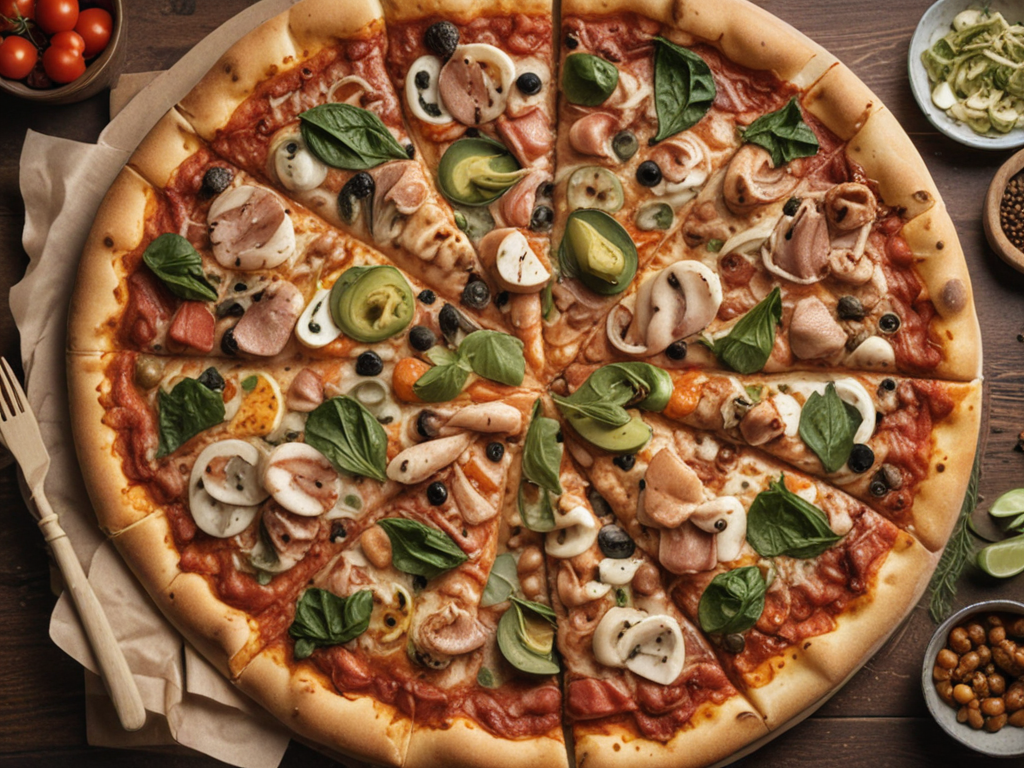
In 2018, it was estimated that over 3 billion pizzas are sold in the United States each year, showcasing the immense popularity of this beloved dish. However, the journey of pizza goes far beyond sheer numbers and consumer demand. From its humble beginnings in Naples to becoming a global culinary phenomenon, the evolution of pizza tells a fascinating story of cultural exchange, innovation, and adaptation. As we explore the various chapters of this culinary tale, we uncover how pizza has transcended borders, embraced diverse ingredients, and adapted to local tastes, marking its place as a truly global icon.
Origins in Naples
The evolution of pizza traces back to its humble beginnings in Naples during the 18th century. Naples, a city known for its vibrant culinary traditions, played a significant role in shaping the pizza that is familiar today. Italian influence, particularly from Naples, is deeply embedded in the essence of this beloved dish.
Naples traditions, characterized by simple yet flavorful ingredients, laid the foundation for the classic Margherita pizza. This iconic creation, topped with tomatoes, mozzarella, and basil, was named after Queen Margherita of Savoy and symbolizes the colors of the Italian flag. The traditional Neapolitan pizza, known for its thin crust and wood-fired cooking method, reflects the culinary heritage of Naples.
Italian influence extended beyond just the ingredients and preparation methods; it encompassed the cultural significance of pizza as well. In Naples, pizza was originally a dish for the working class, offering a delicious and affordable meal. This notion of accessibility and enjoyment has continued to be a defining feature of pizza worldwide.
Spread to America
When pizza made its way to America, New York City played a pivotal role in popularizing this Italian dish. The diverse cultural landscape of the United States led to the evolution of pizza toppings, with unique combinations like pepperoni and pineapple becoming American favorites. This culinary phenomenon not only transformed the way Americans ate but also influenced the broader landscape of American cuisine.
Pizza in New York
Having originated in Naples, pizza quickly gained popularity in New York City, marking the start of its spread across America. New York is renowned for its distinctive pizza styles, including the classic New York slice and the thicker Sicilian square. Iconic pizzerias like Lombardi’s, which opened in 1905 as the first pizzeria in the U.S., and Di Fara Pizza, known for its meticulously crafted pies, have solidified New York’s reputation as a pizza mecca. The city’s pizza scene is a vibrant tapestry of flavors and traditions, with each slice telling a story of culinary innovation and cultural fusion.
| Iconic Pizzerias | Pizza Styles | Notable Features |
|---|---|---|
| Lombardi’s | New York Slice | Oldest pizzeria in U.S. |
| Di Fara Pizza | Sicilian Square | Meticulously crafted |
| Joe’s Pizza | Neapolitan | Popular by locals |
Popular American Toppings
Originating in New York City, the evolution of pizza in America took a significant turn with the introduction of popular American toppings. Meat lovers, a classic choice, became a prominent option on pizzas across the nation. The combination of savory meats like pepperoni, sausage, and bacon became a staple for those seeking a hearty and satisfying slice. Another beloved topping that emerged in the American pizza scene is BBQ chicken. This unique twist brings together the smoky flavors of barbecue sauce with tender chicken pieces, creating a sweet and savory taste that has captured the palates of many pizza enthusiasts. These popular American toppings have not only diversified the pizza landscape but have also become symbols of culinary freedom and creativity.
Influence on Cuisine
The influence of pizza on American cuisine has been profound, shaping the way in which this beloved dish is enjoyed and celebrated across the nation. Pizza’s journey to America ignited a wave of culinary innovation, promoting global fusion and taste exploration. This cultural exchange brought forth a myriad of toppings and styles, reflecting the diverse tapestry of American society. From the classic New York slice to deep-dish Chicago pies, pizza has become a symbol of unity, where people of all backgrounds come together to savor a slice of comfort and tradition. Through this gastronomic evolution, pizza continues to transcend borders, connecting people through a shared love for this iconic dish.
| Culinary Innovation | Global Fusion | Taste Exploration | Cultural Exchange |
|---|---|---|---|
| Diverse Toppings | Fusion Pizzas | Unique Flavors | Shared Tradition |
Fusion With Local Flavors
As pizza spread globally, it underwent fascinating transformations by incorporating unique ingredient combinations that catered to diverse palates. Cultural influences played a significant role in shaping the taste profiles of pizzas, resulting in a rich tapestry of flavors. These regional variations reflect the fusion of traditional pizza-making techniques with local culinary traditions, highlighting the adaptability and versatility of this beloved dish.
Unique Ingredient Combinations
Combining traditional pizza elements with locally sourced ingredients has sparked a culinary revolution in the world of pizza-making. The incorporation of exotic toppings and the art of culinary fusion have led to innovative and unique flavor combinations that tantalize taste buds worldwide. From kimchi-topped pizzas in South Korea to curry-infused sauces in India, these inventive creations demonstrate the endless possibilities when traditional Italian pizza meets local influences. By embracing regional ingredients such as kangaroo meat in Australia or reindeer sausage in Scandinavia, pizzerias have elevated the pizza experience, catering to diverse palates and celebrating the richness of global culinary diversity. This fusion of traditional and local flavors not only showcases creativity but also highlights the evolving nature of pizza as a versatile and adaptable dish.
Cultural Influences on Taste
Drawing inspiration from diverse culinary traditions, pizza chefs around the world skillfully blend local flavors with traditional Italian techniques to create a harmonious fusion that delights the senses. Flavor pairings play a vital role in this culinary alchemy, with ingredients like kimchi in South Korea, tandoori chicken in India, or jerk chicken in Jamaica finding their way onto pizzas alongside classic toppings. These fusion creations not only reflect the local tastes and preferences but also showcase the adaptability and creativity of pizza makers worldwide. By incorporating regional ingredients and culinary traditions into the beloved pizza canvas, chefs are able to offer unique and exciting flavor experiences that cater to a global audience seeking new and innovative taste sensations.
| Culinary Tradition | Flavor Pairings |
|---|---|
| Italian | Prosciutto and Arugula |
| Indian | Tandoori Chicken with Mint Chutney |
| Mexican | Spicy Chorizo with Jalapeños |
Regional Pizza Variations
Exploring the diverse culinary landscapes across the globe reveals a myriad of regional pizza variations that skillfully blend local flavors with traditional techniques, creating unique and tantalizing fusion creations. Traditional techniques, such as wood-fired ovens or specific dough preparation methods, form the backbone of these regional styles. In my travels, I’ve encountered pizzas that harmoniously merge the essence of the local cuisine with the fundamental principles of Italian pizza-making. From the spicy curries topping pizzas in India to the use of reindeer meat in Finland, each variation showcases a deep-rooted connection to the region’s culinary heritage. Additionally, these regional pizzas are not bound by tradition alone; they also embrace modern interpretations by incorporating innovative ingredients and cooking methods, demonstrating the dynamic evolution of this beloved dish.
Rise of Fast Food Chains
Fast food chains have played a significant role in the global proliferation of pizza consumption. The convenience and speed of service offered by these chains have greatly contributed to the popularity of pizza worldwide. Fast food innovation in the pizza industry has led to the creation of new flavors and convenient packaging, catering to consumer preferences and market trends. This has allowed pizza to become a staple food choice for many individuals around the globe.
| Fast Food Chains’ Impact on Pizza Consumption |
|---|
| Accelerated global spread of pizza |
| Introduction of new pizza flavors |
| Convenient packaging for on-the-go consumption |
| Meeting diverse consumer preferences |
Through globalization, fast food chains have been able to introduce pizza to new markets and adapt it to local tastes, further fueling its popularity. This trend showcases the adaptability of pizza as a fast food option that can cater to a wide range of preferences and lifestyles.
Gourmet Pizza Trend
The surge in demand for artisanal pizzas crafted with high-quality ingredients reflects a growing preference for gourmet pizza options among consumers globally. This trend towards gourmet pizzas showcases a shift in consumer preferences towards more sophisticated and unique flavor profiles. Artisanal toppings, such as truffle oil, prosciutto, arugula, and fig spread, are becoming increasingly popular as consumers seek elevated dining experiences.
Culinary creativity plays a significant role in the gourmet pizza trend, with chefs experimenting with unconventional ingredient combinations to create new and exciting flavor sensations. From fusion-inspired pizzas blending international cuisines to locally sourced seasonal toppings, the gourmet pizza trend offers a diverse range of options for adventurous food enthusiasts.
The emphasis on using premium ingredients and innovative flavor pairings distinguishes gourmet pizzas from traditional offerings, appealing to consumers seeking a more refined dining experience. As the demand for artisanal and creatively crafted pizzas continues to rise, the gourmet pizza trend is expected to flourish, inspiring chefs to push the boundaries of traditional pizza-making techniques.
Vegan and Gluten-Free Options
Within the domain of pizza evolution, the rise of vegan and gluten-free options marks a significant shift towards catering to diverse dietary preferences. As more individuals adopt vegan lifestyles or require gluten-free diets due to health reasons, the pizza industry has responded by offering innovative alternatives. Vegan substitutes such as dairy-free cheese, plant-based proteins like tofu or seitan, and an array of fresh vegetables provide a flavorful and cruelty-free option for pizza lovers. Additionally, the availability of gluten-free crusts made from alternative flours such as rice flour, almond flour, or cauliflower allows those with gluten sensitivities to enjoy this beloved dish without compromising on taste or texture.
These advancements in pizza customization not only accommodate specific dietary needs but also contribute to the overall inclusivity of the culinary world. By embracing vegan and gluten-free options, pizzerias demonstrate a commitment to providing delicious choices for all customers, regardless of their dietary restrictions. The evolution of pizza towards more diverse and health-conscious offerings reflects a growing awareness of the importance of culinary freedom and accessibility for all.
Social Media Influence
The growing influence of social media within the pizza industry highlights the changing landscape of marketing strategies and consumer engagement. As a pizza enthusiast, I have witnessed firsthand how social media has transformed the way we interact with our favorite food. Here are three ways social media is shaping the pizza industry:
-
Influencer Partnerships: Collaborating with influencers has become a popular strategy for pizza brands to reach a wider audience. By partnering with social media personalities who have a large following, pizza companies can increase brand visibility and credibility among consumers.
-
Viral Challenges: Social media platforms have given rise to viral food challenges, where users attempt unique pizza creations or eating feats. These challenges create buzz around pizza brands and encourage user-generated content, fostering a sense of community and engagement.
-
Engagement and Feedback: Social media provides a direct channel for pizza companies to engage with customers, gather feedback, and address concerns in real-time. This instant communication helps build customer loyalty and allows brands to adapt quickly to changing preferences in the market.





